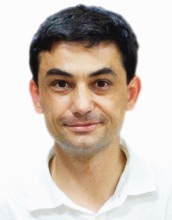Dr. Alain Maestrini

I received in 1993 the M.S. degree in telecommunications and electrical engineering from the ENST de Bretagne, France. From 1993 to 1995 I worked as an engineer in the receiver group of the IRAM 30 m telescope, Spain. I received in 1999 the Ph.D. degree in electronics, jointly from the Université de Bretagne Occidentale and the Observatoire de Paris.
The same year, I joined the Submillimeter-Wave Advanced Technology group at the Jet Propulsion Laboratory, Pasadena, California, to work on solid-sate THz local oscillator development for the heterodyne instrument of the Herschel Space Observatory. I returned to the Observatoire de Paris in 2002 at the Laboratoire d’Étude du Rayonnement et de la Matière en Astrophysique (LERMA) to work on the design of the Mars Atmosphere Microwave Brightness Observer front-end.
In 2003 I joined the Laboratoire des Instruments et Systèmes d’Ile de France (now Laboratoire d’Electronique et d’Electromagnétisme), Université Pierre et Marie Curie–Paris 6 as an assistant professor in electronics and microwaves and became the same year a technical advisor for the Jet Propulsion Laboratory. In collaboration with JPL, and in association with LERMA, I designed in 2003-2004 several new frequency multipliers for the local oscillators of Herschel. On January 1st, 2008, I joined LERMA as a permanent member. In 2009, I received the Arago award, awarded every four years by the French Academy of Sciences for work related to the field of astronomy.
I focussed my research on integrated millimeter and submillimeter-wave front-ends for radio astronomy and planetary science and on frequency-multiplied sources at frequencies above 2 THz. Since October 2006, I am working in close partnership with CNRS-Laboratoire de Photonique et Nanostructures (now Centre de Nanosciences et de Nanotechnologies) to develop a Schottky diode process for THz mixers and frequency multipliers.
Since 2017, I am responsible of LERMA instrumentation group, which is involved in several R&D programs on THz devices and systems. LERMA is a member of the Submillimeter Wave Instrument (SWI) consortium for ESA JUpiter ICy moons Explorer. Since June 2016, LERMA instrumentation group is responsible of delivering the high frequency part of JUICE-SWI 1200GHz channel frontend.
JUICE is the first Large scale mission of ESA Cosmic Vision 2015-2025 program. SWI will investigate the temperature structure, composition and dynamics of Jupiter's stratosphere and troposphere, and the exospheres and surfaces of the icy moons. SWI is a heterodyne spectrometer using a ~30 cm effective aperture antenna and working in two spectral ranges 1080-1275 GHz and 530-625 GHz with spectral resolving power of ~1E7.

Frequency Multipliers: the most common way to build frequency-tunable sources at sub-millimeter wavelengths is by frequency multiplication. This solution is used for all of the Local Oscillators of HERSCHEL-HIFI and for most of the local oscillators of ALMA.
A short biography
Position : Maître de Conférences (Associate Professor)
Affiliation : Université Pierre et Marie Curie–Paris 6 / Observatoire de Paris
Laboratory : Laboratoire d’Étude du Rayonnement et de la Matière en Astrophysique et Atmosphères, Observatoire de Paris.
Domain of Interest : T-wave generation by frequency multiplication. Heterodyne detection at THz frequencies for astrophysics, planetology and the science of the atmosphere.
International Symposium on Space THz Technology :
This conference is an important event for scientists interested in THz technologies and instruments for millimeter and sub-millimeter radio-astronomy: http://www.space-thz.org
Learn more about my work ...
You need to activate JavaScript to properly navigate through this site. An up-to-date browser is also recommended. You can have a direct access to my web pages by using the following links:
| Home | Research | Publications | Contact |


